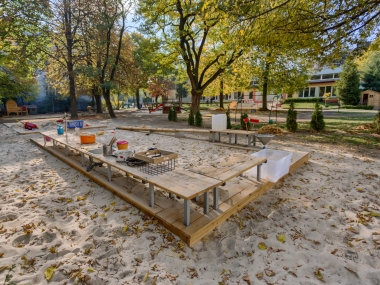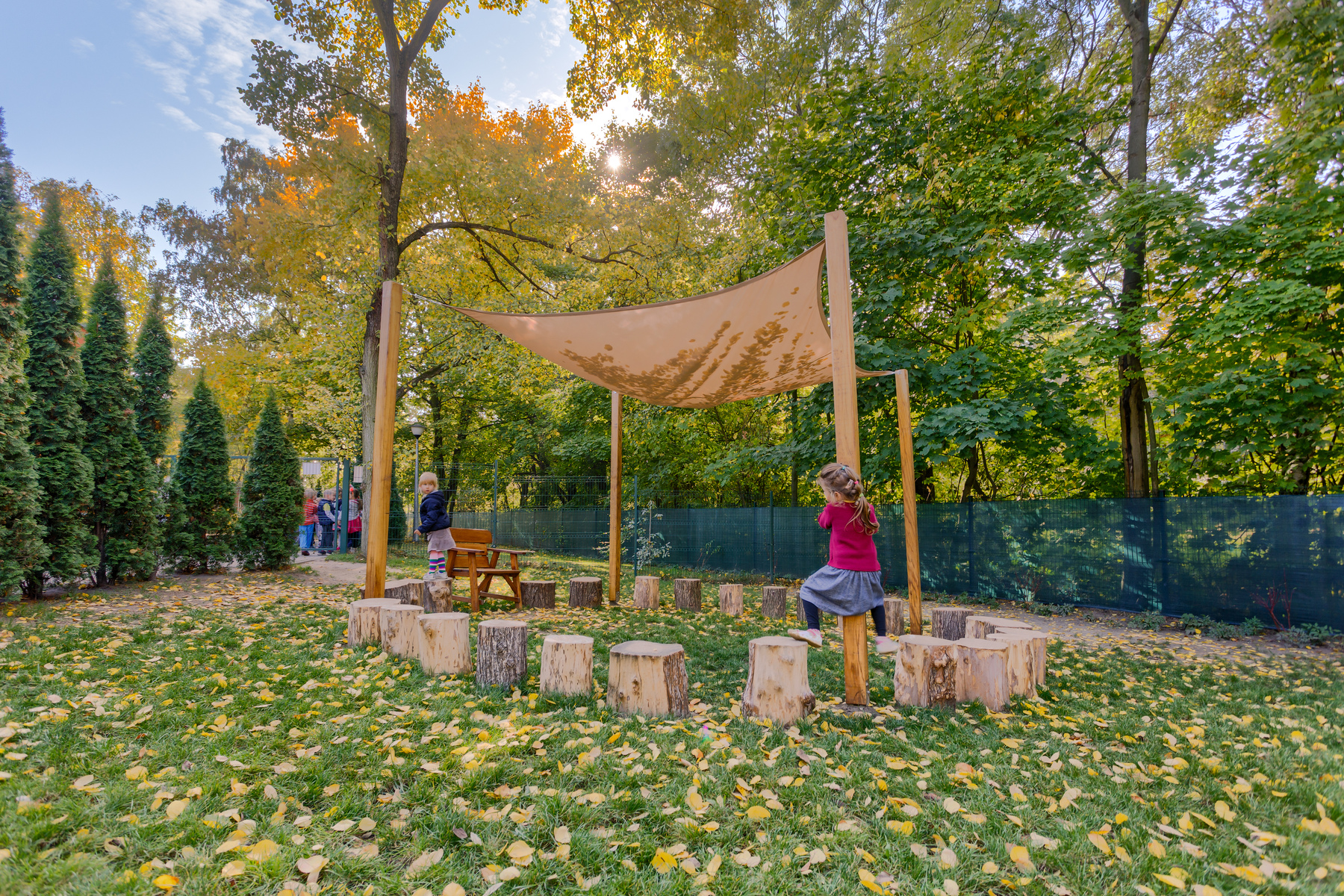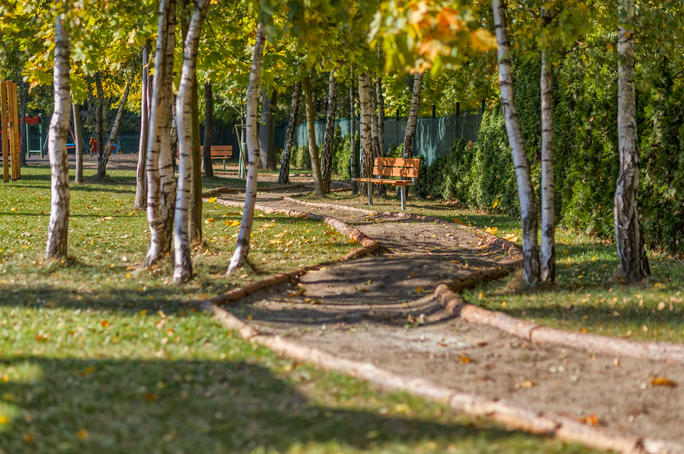Natural playgrounds of Poznan
Edited on
26 August 2021In his book "The Last Child of the Forest", Richard Louv defines the syndrome of deficit of contact with nature in children. He notes that children living in cities have limited access to free play in the bosom of nature, which has a negative impact on their psyche, ability to concentrate, motor coordination and physical condition. Natural playgrounds are the antidote to these issues.

Made of natural materials, they implement the principle of multi-sensory interaction: with color, texture, smell, sound, a variety of materials or a varied terrain. Natural playgrounds allow for creative, free play and intimate contact between the child and nature, providing the possibility of direct experience of nature, and on the scale of the entire city - create an additional attractive space amidst greenery.
Space for imagination
A typical playground is usually a square devoid of greenery, level, with an artificial surface, equipped with ready-made, catalog play equipment. Excessive sunlight is another frequent problem - shadeless "desert" playgrounds become empty on hot days due to high temperature, making it impossible to play comfortably. Synthetic surfaces reduce the amount of oxygen in the soil and prevent the natural absorption of water; they also age quickly and require costly replacements. In addition, a perfectly aligned square, equipped with devices with one specific function, quickly becomes boring to children who constantly require new stimuli for development.
As opposed to the standards of playgrounds in Poznań, spaces are being promoted that resemble a garden rather than a playground. Places full of greenery, with trees and plant structures forming a natural shade and a friendly microclimate, with a natural surface that allows the earth to retain valuable water and is healthier for children in direct contact. Play areas made of natural elements, such as a hill or a tree trunk, never get boring, as they do not have one specific function and are conducive to children's imagination.
A natural playground is a place where natural elements complement standard play equipment. Synthetic surfaces are replaced with natural ones - earth, sand or grass. Children have at their disposal garden elements made of natural materials, such as a mound or an earth path with tree bough edges, elements of live vegetation: a shrub maze, a hut made of live wicker or paths for activities made of tree trunks and logs. In addition, children can play freely, using sand and water, "mud kitchen" being one example. A significant part is formed by zones intended for plant cultivation and insect observation, e.g. green beds, fruit bushes and insect houses. Some elements can be individually designed, e.g. a wooden platform or a wall with a window for interactive games. The space is complemented by small garden architecture - benches, tables, gazebos. Importantly, experiences during the implementation of works demonstrate that the use of natural elements in the playground is often much cheaper than a purchase of ready-made play equipment or the use of a synthetic surface - due to the wide range of arrangement possibilities.

Mud kitchen in the garden of Kindergarten No. 87 in Poznań, Piotr Bedliński, source: the City of Poznań
Innovative on a national scale
In Poznań, in the years 2016-2018, three natural playgrounds were created in the kindergarten gardens of Kindergartens No. 42, 46 and 87, as part of the "Active methods of preschool education" pilot project, implemented by the Office of Project Coordination and Revitalization of the City of Poznań. These activities were inspired by study visits to Berlin kindergartens, carried out as part of the international YALE project in 2013–2015. The aim of the project was to introduce and test innovative solutions in the arrangement of kindergarten space. Instytut Małego Dziecka im. Astrid Lindgren was a substantive partner of this undertaking - an association of experts in the field of young children education - and the design of the gardens was entrusted to a landscape architect Anna Komorowska from the ”pracowania k.”, specializing in the design of natural playgrounds. When designing the gardens, particular emphasis was placed on participation. The conceptual designs of the gardens were consulted with both the preschool staff and the future users - children. As a result, the solutions created as part of the project proved to be innovative not only for Poznań, but on the scale of the entire country.
During the implementation of the project, users voiced certain concerns (especially parents of children) regarding safety issues related to children getting dirty, direct contact with insects or stinging plants. In order to dispel these fears and promote the idea of a "natural playground", the city carried out a series of information and promotion activities. As part of the project, the publication "Kindergarten garden. A Guide ", was published, containing practical tips on arranging a kindergarten garden and describing examples created during the pilot program. In November 2018, the seminar "Natural playgrounds in kindergarten gardens" was held, with experts from the “pracownia k.”, the Playground Control Center and preschool directors offered inspiration and dispelled the participants' concerns about the safety of such solutions. In addition, in 2019, four editions of workshops for preschool staff were organized, with principals and teachers trying their hand at designing their own kindergarten garden in the spirit of natural playgrounds. As a result, not only educational institutions, but also housing estate councils and the residents themselves began to express their interest in creating natural playgrounds.

A meeting circle in Kindergarten No. 46 in Poznań, Piotr Bedliński, source: the City of Poznań
The activities are not over
Currently, the City of Poznań continues to implement the idea of natural playgrounds. As part of the inter-departmental cooperation between Project Coordination and Urban Regeneration Office and the Department of Education, a support program for kindergartens in this area was created, implemented in the years 2019-2020. As part of the program, a total of 20 kindergartens received a subsidy for the modernization of gardens, as well as support in the form of cooperation with a landscape architect. The designer carried out an in-depth diagnosis of needs in kindergartens and, on this basis, she designed projects for the development of kindergarten gardens in the spirit of a natural playground. This was accompanied by workshops for preschool staff, aimed at introducing this idea. The grant made possible to carry out only part of the works, but the project itself provided kindergartens with the opportunity to obtain further funds in the coming years and perform consistent development of space. In addition, 41 kindergartens in Poznań received in total 178 ecological demonstrators from the city , i.e. garden micro-installations for environmental education, such as a table planted with live vegetation, a hut made of live willow or green discounts. The design process, workshops and part of eco-demonstrators were financed by the CONNECTING Nature project under the Horizon 2020 Framework Program. Additionally, for up-scaling eco-demonstrators concept Project Coordination and Urban Regeneration Office raised grants from Regional Fund for Environmental Protection and Water Management.

Dirt path in the garden of Kindergarten No. 46 in Poznań, Piotr Bedliński, source: the City of Poznań
Katarzyna Bogdańska-Głuchowska
Dominika Dymek
Project Coordination and City Revitalization Office
Poznań City Hall
 Submitted by Viktoria Soos on
Submitted by Viktoria Soos on
